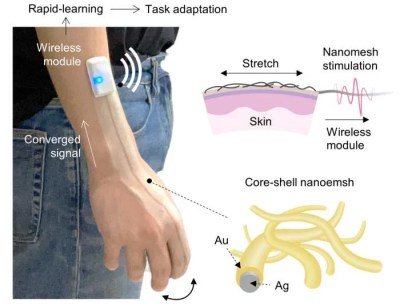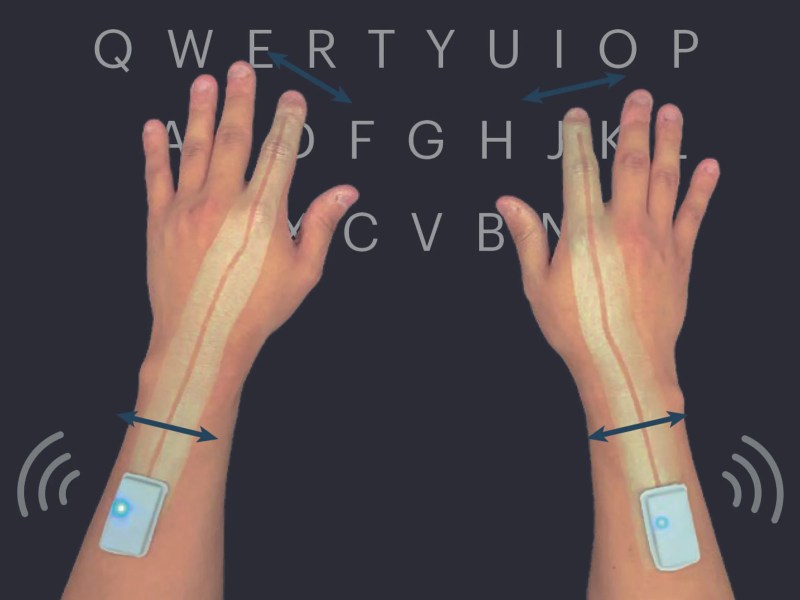We’ve all seen those ‘nothing’ keyboards, where the keys themselves are not much more than projected lasers, and users are asked to ritually beat their poor fingertips into the table — which has little give and even less clack. Well, a team at the Korea Advanced Institute of Science and Technology have come up with a way to eschew the keyboard altogether.
 Essentially, the user wears a thin, breathable mesh of silver nanowires coated in gold, which is then embedded in a polyurethane coating. The mesh is sprayed onto their forearms and hands on the spot, and the mesh terminates in a small enclosure that is also worn on the skin. This contains a small Bluetooth unit that beams data back to a computer, a machine, or potentially another user wearing the same type of unit.
Essentially, the user wears a thin, breathable mesh of silver nanowires coated in gold, which is then embedded in a polyurethane coating. The mesh is sprayed onto their forearms and hands on the spot, and the mesh terminates in a small enclosure that is also worn on the skin. This contains a small Bluetooth unit that beams data back to a computer, a machine, or potentially another user wearing the same type of unit.
As the skin stretches and contorts, the mesh senses small electrical changes within. These changes become meaningful with applied AI, which maps the changes to specific gestures and manual tasks. To do this, the team started with teaching it to distinguish between patterns from tasks like typing on a phone, typing on a regular keyboard, and then holding and interacting with six differently-shaped simple objects.
The team isn’t stopping there — they plan to try capturing a larger range of motion by using the nanomesh on multiple fingers. In addition to facilitating communication between humans and machines, this could leave a huge fingerprint on gaming and VR.















I hope they invented something skin friendly, because standard band aids give me a rash after a few hours.
Happens to my wife too. We tried a bunch of different ones, Ikea sells some that don’t bother her.
This could be an allergy against natural latex, often combined with a cross allergy against bananas. Like with my brother, who has this condition.
Now just invent a portable holographic display and you have tomorrow’s Star Trek Discovery control panel screen thingies today! An extra 3,000 years not required.
See that one failed laser keyboard. Put a piece of glass in front of it, and you have it done without an extra 3010 years.
How long until a direct brain to computer interface? I’ve been waiting for that for at least 30 years. This does seem to be a step in the right direction. It is at least a lot less intrusive than a big honey dipper sticking out of your ear…
I would not like to have any brain surgery without having a severe medical emergency.
I agree on the outside appearance, but that requires probably the single most intrusive surgery to-date ( I mean, as in cutting in your skull, slapping a pair of electrodes on your brain and patching your skull back up, leaving you with 30 grand poorer)
Geez man, why so negative? Don’t you know that negative comments get removed on Hackaday?
I did not mention brain surgery at all. Why not just something simple like fMRI built into a baseball cap?
That would be basically only one way interface. Read, but not send. If you get ability to get feedback from baseball cap – now we are talking ;-)
*The monkey’s paw curls one finger*
That’s exactly what Neuralink is working on, and they apparently have prototype dev units that were inserted into monkeys.
It’s essentially a piece of fabric with tiny/short spike electrodes, you open up the skull and lay it down onto the surface of the brain, then close up the skull. (I don’t think the spike electrodes are meant to pierce the cells, I think it’s just to magnify the electric field.)
The electrodes sense signals in layer 6 of the cortical columns, and with some external processing and a bit of AI they can learn which signals mean which.
The first application will be disabled people, they expect human trials in about 6 months from now.
(The monkeys are otherwise well treated, and had previously been part of other medical experiments and were scheduled to be killed anyway.)
With the implants, they could produce works of Shakespeare much faster!
I’m impressed at their application, but this has already been done better, for like $80. You have stereo cameras watching the hands and apply the AI to the image. Their technique requires you to spray an expensive disposable nanomesh onto your skin, right?
I’m not sure these are comparable. With the spray on, yes, they’ll need to figure out a way to make it cheap enough to be disposable. Who knows if that’s even possible. Your solution, though, requires being in front of a camera. Great for single use applications but not as friendly for anyone who wants to move around and do other things
Why not just embed the works into a pair of gloves instead of something attached directly to the skin?
Tech hackers seem obsessed with attaching or embedding electronics into their body and I just don’t get it. Don some clothing that does the same thing, and save yourself a trip to the surgeon. Think of your future self; it’s never fun to upgrade something that has been permanently installed!
Did this reeeeally need gold coated silver nanowires? Maybe we could just do some regular strain gauges with conductive rubber? No? aight…
Remember when people were amazed by the “Minority Report” arm-waving interface?
Then people realized that you spend nearly all of your time “resting” when you operate something, and making your input device REQUIRE you to hold your fingers/hands/arms up in specific positions to stop you from accidently “using” the machine is INCREDIBLY tiring?
No Thanks.
And while you are at it, give me back my touchpad buttons.
Having a spot that I have to press/deform to do something, that will ALSO move my cursor away from my target AS I press/deform the button is infuriating.
Don’t take away my resting zone.
Using Minority Report, which had to be filmed in a way the audience would understand, is a bad example. This tech is impressive because of the detail it can capture. This could be used to replace pens, meaning you can literally take notes anytime, anywhere, no pen and paper or phone/tablet required. Learning to play the guitar or literally anything else that involves physical movement? Get detailed recommendations tailored precisely to you. Or have complete control over your IoT devices by connecting with IFTTT to say “if I’m in _____ location, and I make ____ gesture, then do _____”. In bed and want to turn the TV off? Pretend a remote is in your hand and turn it off. Want to feel like a Jedi? Program smart doors to open with a hand wave.
Etc.